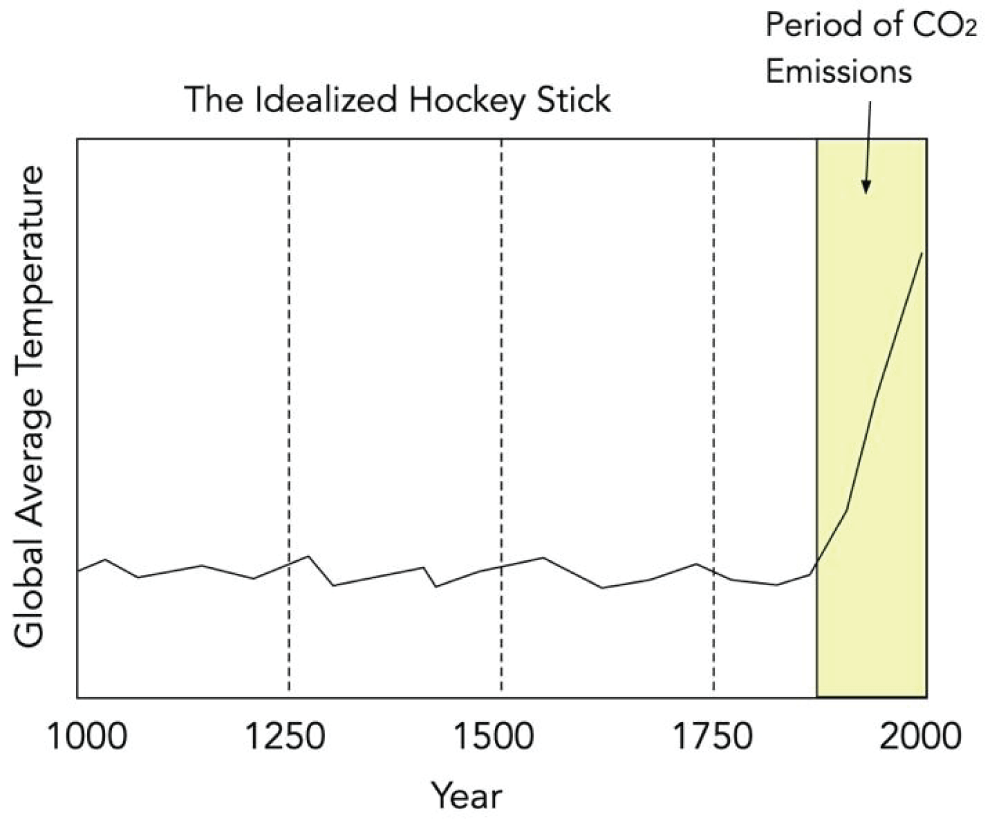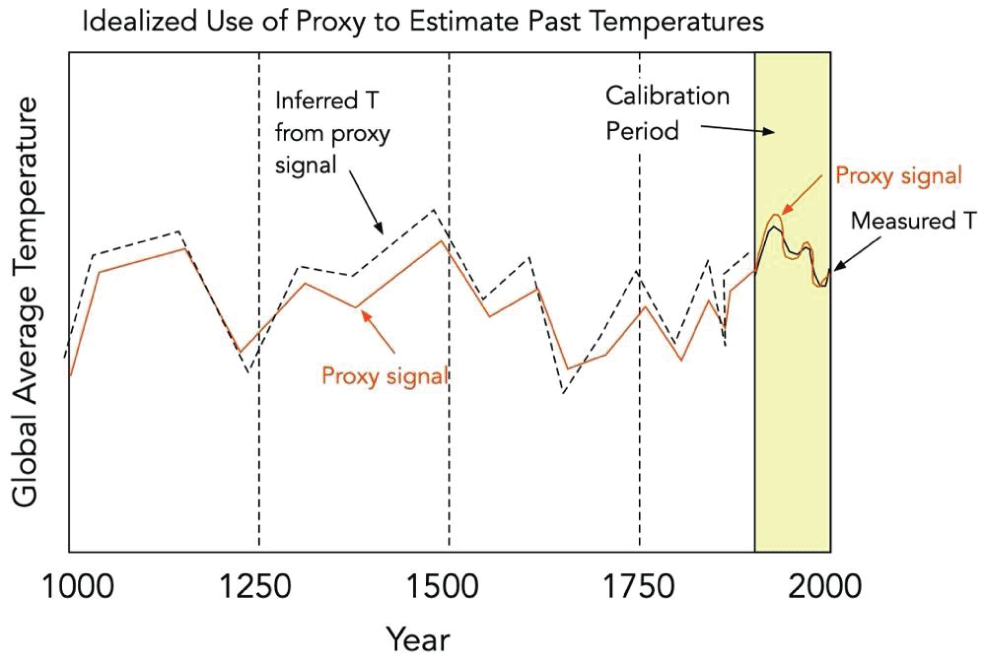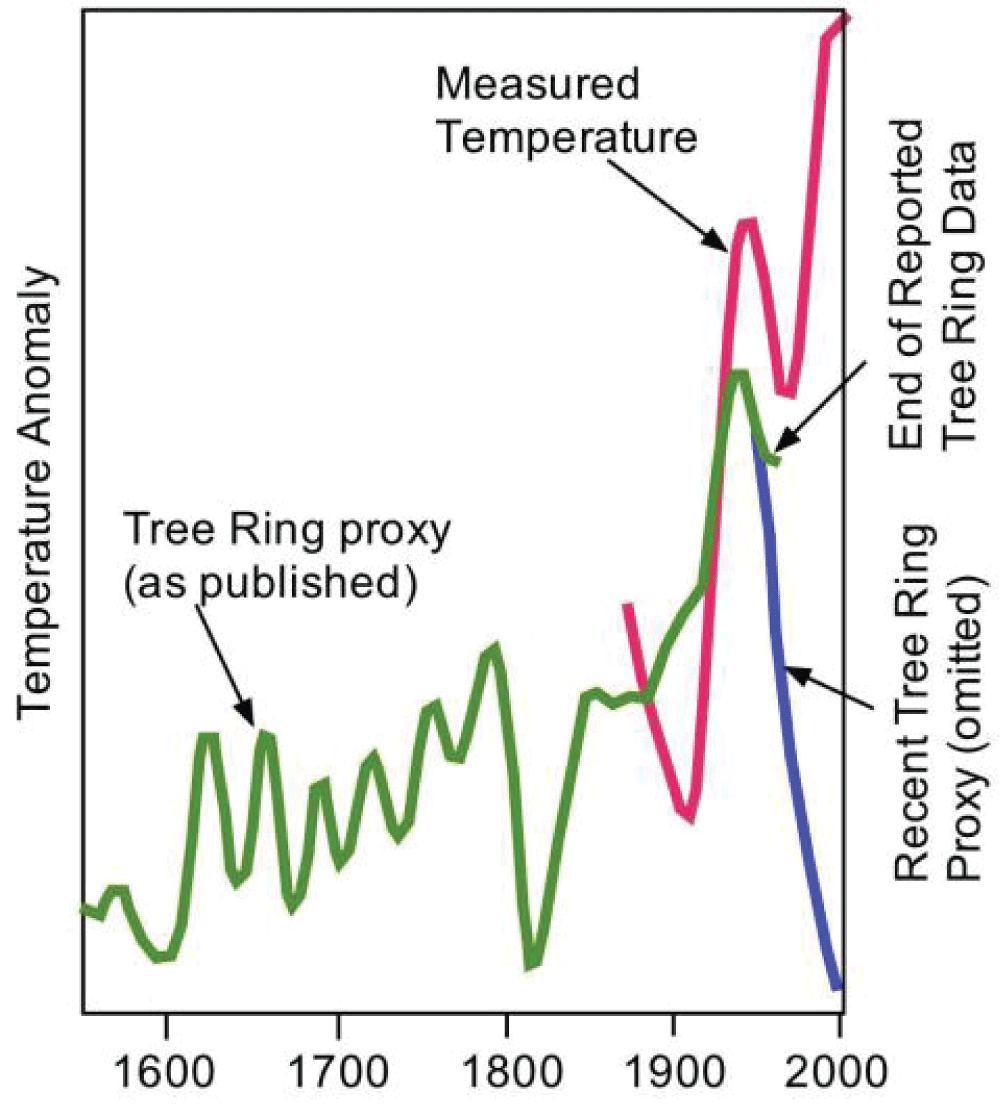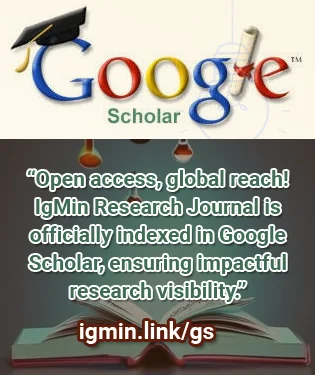摘要
Near the turn of the 21st century, several climate scientists believed that rising CO2 was the cause of observed warming and sought to support this by showing that excursions in the Earth temperature were small for the past 2,000 years, with a sudden increase in the 20st century at the same time period when CO2 emissions increased (a so-called “hockey stick” shape to the temperature vs. time plot). To do this, they employed a large number of proxies (such as tree rings) to estimate the Earth’s temperature over the last 2,000 years. Each proxy was compared to the measured temperature during the calibration period (the 20st century), and this relationship was used to convert up to 2,000 years of proxy measurements to estimated temperature. A sophisticated algorithm was used to process the large amount of data from multiple proxies into a yearly average temperature for up to 2,000 years. Unfortunately, they made several mistakes in the statistical analysis, one of which produced a significant statistical error. This error, in which they standardized the data against the mean during the calibration period (rather than the entire data set) had the effect of almost ignoring most of the proxies, while heavily weighting those few with an increase in the 20st century – thus artificially producing a hockey stick form to the plot of temperature vs. time. In addition, the innate merit of many proxies is dubious. The climate scientists involved appeared to ignore valid criticisms from outside their peer group, and they continued to claim the hockey stick result. Climate scientists also vigorously opposed any suggestion that factors other than CO2 also affected the climate. Climate scientists introduced elements of political influence into scientific discourse by actions such as loading up a thin paper with a large number of authors – publishing votes of confidence rather than scientific results.






![Reconstructed temperatures since 1400 [1]. Note that the mean is for 1902–1980. Also note that the 2σ error bars are so wide that they could hide almost any imaginable temperature curve [1].](https://www.igminresearch.cn/articles/figures/igmin296/igmin296.g003.png)
![Temperature anomaly vs. year since AD 1000. Adapted from Mann, Bradley, and Hughes [2]. The X at the far right is their estimate for 1998. Note that the mean is for 1902–1980.](https://www.igminresearch.cn/articles/figures/igmin296/igmin296.g004.png)
![Some of the proxies used by Mann, et al. [5].](https://www.igminresearch.cn/articles/figures/igmin296/igmin296.g005.png)
![Estimates of historical temperatures by Mann, et al. and others [5]. Mann, et al. exaggerated the temperature rise at the far right. The actual temperature change is shown as a black dashed line. In either case, substituting measured temperature for modeled temperature hides the model where it fails.](https://www.igminresearch.cn/articles/figures/igmin296/igmin296.g006.png)
![Comparison of rework of the North American tree network first principal component (PC1) using MBH centering on the calibration period vs. using centering across the entire time span of the data set. The hockey stick is shown to be an artifice of the procedure. Adapted from Wegman, Scott, and Said [43].](https://www.igminresearch.cn/articles/figures/igmin296/igmin296.g007.png)
![“Spaghetti chart” of individual proxies (except Mongolia). Adapted from McIntyre [45].](https://www.igminresearch.cn/articles/figures/igmin296/igmin296.g008.png)
![Simple average of proxy data from Esper, Cook, and Schweingruber [44]. Adapted from McIntyre [45].](https://www.igminresearch.cn/articles/figures/igmin296/igmin296.g009.png)
![Temperature anomalies from MBH. The lower graph is the result of MBH98 while the upper graph is a simple average of their proxies [46].](https://www.igminresearch.cn/articles/figures/igmin296/igmin296.g010.png)
![Eight reconstructions of historical northern non-tropical summer temperatures using various procedures. The heavy line (Briffa-01) is “preferred” [47].](https://www.igminresearch.cn/articles/figures/igmin296/igmin296.g011.png)
![Comparison of reconstructions. M-98-99 = Mann, et al. [1]. BO-99 = Briffa and Osborne (1999). J-98 = Jones, et al. (1998). CL-00 = Crowley and Lowery [21]. B-01 = Briffa, et al. [47].](https://www.igminresearch.cn/articles/figures/igmin296/igmin296.g012.png)

![Temperature reconstructions. Adapted from Burger and Cubasch [53].](https://www.igminresearch.cn/articles/figures/igmin296/igmin296.g014.png)
![Variation of Nino index from 1980 to 2010 [3].](https://www.igminresearch.cn/articles/figures/igmin296/igmin296.g015.png)
![Integral of the Southern Oscillation Index (SOI) anomaly from 1950 to 2000. (Negative values of SOI indicate predominance of El Niños) [3].](https://www.igminresearch.cn/articles/figures/igmin296/igmin296.g016.png)
![Integral of Douglass’ modified El Niño index [65].](https://www.igminresearch.cn/articles/figures/igmin296/igmin296.g017.png)
![Comparison of Douglass’ modified El Niño index and its integral with measured global surface temperature anomalies and tropospheric temperature anomalies [3,65].](https://www.igminresearch.cn/articles/figures/igmin296/igmin296.g018.png)
![Comparison of rework of the North American tree network PC1 using MBH centering vs. using centering across the entire time span of the data set. The hockey stick is shown to be an artifice. Adapted from Wegman, Scott, and Said [43].](https://www.igminresearch.cn/articles/figures/igmin296/igmin296.g019.png)


